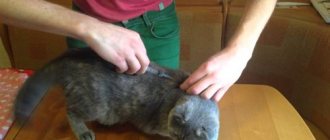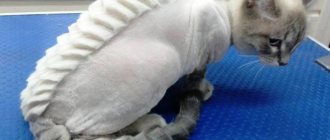Ekaterina Shulga
veterinary therapist
Veterinarians often prescribe subcutaneous injections to your pet, and the most common place for them is at the withers. Let's look in detail at how to give an injection to a cat at the withers at home. This skill will reduce the animal’s stress from going to the clinic and save your time.
- Choosing a syringe and needle
Where is the withers located in cats?
Let's figure out where to look for a cat's withers. The withers are the area where the back and neck connect. Most of it is located immediately above the shoulder blades; the skin in this place easily folds, creating a “pocket” where the injection can be made.
Why are injections given at the withers?
To quickly administer the drug and reduce pain, an injection is given to the cat at the withers. The area above the shoulder blades is insensitive, and when injected under the skin, the pet experiences virtually no uncomfortable sensations. The loose structure of the subcutaneous tissue, if necessary, allows the introduction of large volumes of solutions, thus conducting infusion therapy (droppers).
Other sites for hypodermic injections in cats
In addition to the withers, you can choose other places for subcutaneous injections. For example, the groin fold or the front of the thigh. The loose structure of the skin in these places makes the injection almost painless. Some drugs are even recommended to be placed specifically in the inguinal fold. It is recommended to place vaccines in the area of the inguinal fold, because this makes it easier to remove post-vaccination sarcoma if a complication occurs.
Possible consequences and methods for eliminating them
Despite the fact that an injection is not so significant and significant as to cause serious consequences, from a medical point of view it is minimal damage to the skin and blood vessels, so you should be prepared for any turn of events .
Regardless of the method of administering the injection, subcutaneously or intramuscularly into the withers, a small amount of blood may appear on the cat’s skin. If its flow does not stop, or becomes more and more, consult a doctor immediately.
You can temporarily stop the bleeding by applying a piece of ice or any sterile cold object to the injection site.
If we talk about pain and irritation after the injection, they are insignificant and soon pass. Don’t be surprised if the cat behaves strangely and tries in every possible way to attract your attention, just so that you can feel sorry for it and console it – felines are no stranger to acting abilities!
© shutterstock
Preparing for the injection
To give an injection to a cat at the withers, you need to be fully armed. Select a syringe, prepare the drug and place for the procedure. If the pet is cowardly or aggressive, find a helper to secure the animal and secure it. To avoid additional stress for your cat, carry out the procedure in a quiet and calm atmosphere. Talk to her, pet her, calm her down. To distract your cat from manipulation, you can offer her treats.
Choosing a syringe and needle
The choice of syringe and needle depends on the size of the animal and the consistency of the drug. If the drug is oily, it is better to choose a needle with a thicker diameter. The thin needle will become clogged and the injection will not be possible. Also, if the drug is oily or in the form of a suspension, the procedure will cause more discomfort. The pet may jerk, causing the thin needle to bend. Therefore, to administer such drugs to adult cats, you can use a 5-10 ml syringe needle, and to kittens - 2-3 ml. If the drug is liquid, then we look at the size of the pet, the thickness of the skin and subcutaneous tissue. For kittens and very thin animals, a needle from an insulin syringe (1 ml) is enough; for more plump cats, a needle from a syringe 2-3 ml. That is, if you are giving an oil preparation to a kitten, you can take a large needle and an insulin syringe - this will make it more convenient to draw a small dose of the solution and inject it without any problems.
Preference is always given to short needles up to 3 cm - this way we reduce the risk of puncturing the skin through, introducing the drug into the muscle or trauma to the skin.
Each syringe has a scale. Depending on its volume, you can draw 1.0 ml, 2.0 ml, 3.0 ml, 5.0 ml, 10 or 20 ml of solution. Most often, 1-5 ml syringes are used for animals. The division features depend on the volume of the syringe, the volume is measured in cubes, one cube is equal to 1 ml:
- in a 1 ml syringe, large divisions are equal to 0.1 ml, small divisions are 0.01 ml;
- in a syringe with a volume of 2.0 ml, large divisions are 1.0 ml, small divisions are 0.1 ml;
- in a syringe with a volume of 5.0 ml, large ones are equal to 1.0 ml, and small ones are 0.2 ml, etc.
Preparing the medicine
Be sure to read the instructions for the drug. Requirements for its storage may differ in temperature - room or in the refrigerator, in access to light - some drugs should be stored in dark places or in dark containers.
Before the injection, it is necessary to warm the drug to body temperature, but not higher than 37 C. To do this, just hold the syringe with the drug in your hand for a few minutes. Most solutions cause discomfort in cats when administered cold.
Prepare the syringe and ampoule. Remove the syringe from the sterile packaging and check that the needle is firmly seated on the cannula. If the ampoule is glass, open it along the marked line by simply pressing it through a cotton pad. Some of them do not have such a mark, in this case, in the thinnest place, run the blade several times (it is usually included in the package of the drug) and press the same way. If it is a bottle and there is a rubber stopper on it, then you do not need to open it. We insert a needle into its center and draw up the drug. If there is protection on the plug - plastic or metal, it must be removed.
Tilt the ampoule slightly to one side, remove the cap from the needle and draw the required amount of the drug into the syringe.
After drawing the drug, lift the syringe with the needle up and release the air until the first drop of solution comes out of the needle. Put the cap back on. Check the dose taken, it should be equal to what the doctor prescribed for your cat. Warm the drug in your hand. If you cannot remove air from the syringe, the drug is foaming or thick, lightly tapping the syringe with your fingers and moving the piston up and down until all the bubbles are released. Also, first you can take the drug and warm it, and only after that - remove the air. So, most foam bubbles will burst on their own.
How to keep a pet?
If you have never given injections to your cat before, no matter the nature of your pet, it is worth being on the safe side.
There are special retainer bags. This bag is a kind of cocoon with locks or Velcro on different parts of the animal’s body. It allows you to isolate some part of the animal for the procedure - paw, tail, back. A soft clamp is fastened around the head, and it remains outside. However, as practice shows, such a bag is not ideal. Many cats become nervous and angry even at the stage of placing them in the bag. Also inside the bag, the cat's paws are free, and animals can stick them into the head hole or tear them with their claws.
In addition to paws with claws, teeth also pose a threat. To protect against them, use a muzzle. There are special muzzles for cats made of thick fabric; they completely cover the face and eyes, and are secured with Velcro behind the ears.
Hurry up, choose a box and find out what gift awaits you
Discount on pet insurance
Promo code copied to clipboard
To ensure your safety from cat teeth, a muzzle made from a plastic bottle is the best life hack. To make it, you need a bottle that is the right size for your pet. If you have a kitten, then you need a 0.5 liter bottle, if you have a large British cat, we take a wide 1.5–2.0 liter bottle. In the place where the neck is, depending on the size of your cat’s head, cut off a part of the bottle 10–15 cm long. Remove sharp edges by covering the cut with electrical tape or adhesive tape if the cut was uneven. Next, on its wide part, at an equal distance from each other, we make holes. We insert ties into them. Unscrew the cap, put it on your head and tie it tightly behind your ears.
Swaddling a cat is an excellent method of restraint that will help not only give an injection, but also give a pill if necessary. Take a large, thick towel/blanket/sheet/shirt and place it on top of the cat so that the head remains open. Pull the right edge of the towel to the left, tightly fixing the paw to the chest, and the left edge to the right. The ends of the towel should be on your back. Keep them taut. Fix the front paws, tuck the remaining free part of the towel from the tail side under the belly and firmly press the resulting cocoon with the cat to a horizontal surface. The denser the resulting cocoon, the less ability and desire the cat has to move. Or, if you have a helper, you can throw a towel over the cat. Press her to a horizontal surface with your chest, and hold her front paws with your hands. The second person administers the injection.
It is always important to calm your pet. If he is very scared, it is better to stop the procedure and give him time to calm down.
Rules
It may sound trivial, but your hands should be clean! If you had to give an injection in unsuitable conditions, use gloves or at least a new plastic bag. A few rules about syringes:
- Injections are made with freshly unpacked syringes.
- The needle must be sterile (it should not be touched with hands) and new. After the first injection of the drug, microscopic burrs appear on the needle, which interfere with repeated injection, that is, 1 injection = 1 new needle. If you need to give injections from one syringe, but several times, purchase syringes with spare needles (their caps are of different colors, so as not to get confused).
Never leave the drug in the ampoule for administration after some time. If you purchased an expensive medicine, draw it into several syringes at once and store it in the refrigerator. Some drugs cannot be stored for more than 10–12 hours after opening the ampoule; in this case, the option of storing in a syringe is also not relevant.
Important! Any drug, even drawn into a syringe, can be stored in the refrigerator for no more than 72 hours.
Injectable drugs, which are sold in powder form, are diluted with saline, novocaine or lidocaine . In this case, read the instructions carefully, since after dilution, the shelf life of the drug is very limited.
Important! If you do not know whether the drug can be stored in a syringe, be sure to consult your doctor.
Be careful, anyone, including you, can make a mistake. I may sell you the wrong drug by mistake, you yourself may confuse the ampoules, or one of your family members, trying to help, may mislead you. Before injecting the drug from the ampoule, read the name. If the expiration date or the name of the drug has been erased from the ampoule, do not use it.
If you are proceeding without your veterinarian's instructions, never mix multiple medications in one syringe . There is a high probability of oxidation of one of them or precipitation. In both cases, the injection will be useless.
The instructions for each drug contain a description of what the liquid or powder should look like. If the description does not match what you see, do not use the drug. There are a number of drugs that are stored only within certain temperature limits. Such medications should only be purchased from trusted pharmacies or from the veterinarian himself.
Even if the drug is prescribed by a doctor and you are given exact instructions, check:
- Is it possible to administer the drug to a pet? Some dog medications are toxic to cats.
- Is it possible to administer the drug subcutaneously? This information is in the instructions.
- What temperature should the drug be when administered? Some solutions need to be heated to 40° or administered cool.
- Are there any warnings in the instructions regarding the speed and method of administration; some drugs need to be administered very slowly or diluted.
- How long should you shake the bottle before withdrawing the drug into the syringe? Sometimes this needs to be done for several minutes or until the drug becomes completely homogeneous.
Modern manufacturers of injectable drugs package medications in ampoules with indicator circles or stripes. Logically, you need to press the ampoule away from you above the indicator and the neck will break off. In fact, you can “fight” with some ampoules for hours or even crush them. If the ampoule does not give in, a special stone is used to file the glass. Be careful, you can seriously cut yourself on the neck and broken part of the ampoule.
The necks of ampoules can be of different diameters. For convenience, a small ampoule (neck up to 2 mm) can be turned upside down and take the drug, don’t worry, it won’t spill out. The drug will flow through a neck of 3 mm or more, so it must be taken by placing the ampoule on a vertical surface.
Dial up the drug 0.5–1 division more than you need to inject. Then lift the syringe up with the needle and tap the syringe with your finger. Please note that you need to knock on the plastic, on the syringe itself, but not on the needle (it cannot be touched). Air bubbles will rise to the nozzle of the syringe. Tilt the syringe so that the bubbles are under the nozzle and press the plunger to expel the air.
Important! Air entering during an injection can only be fatal if we are talking about a large bubble that went through a dropper or a large volume of air injected directly into a vein.
With a subcutaneous injection, you need to get rid of the air in the syringe as much as possible, but one small bubble will not cause any problems.
General recommendations
Do not panic. The more afraid you are, the more unnecessary movements and sounds you will make that can frighten the cat. Your pet may sense something is wrong and begin to panic before you even begin to notice.
In order not to be distracted by searching, prepare everything you need in advance and put it within reach.
Carry out the procedures at rest. For example, when the cat has just woken up or started its normal daily activities. Do not perform the procedure when she is angry, playful, or completely in the mood for contact with you.
Calm your pet and talk to him throughout all manipulations.
If at the time of injection you see that the fur has become wet, then you have pierced the skin right through and the solution has begun to flow out. It is worth stopping the procedure.
Differences between subcutaneous and intravenous injections
The most common methods of administering drugs in veterinary practice are subcutaneous, intramuscular and intravenous techniques.
Subcutaneous injections differ from intramuscular injections in the depth of needle penetration into the tissue and the possible permissible volume of injected drugs and solutions. The withers area of a cat, unlike other places on the pet’s body, has the least pronounced pain, since not many nerve endings are concentrated there. And, unlike thigh muscle tissue, injection of drugs into this area does not cause significant pain in the pet. A much larger volume of liquid can be administered subcutaneously than intramuscularly, since the subcutaneous tissue in animals is quite elastic and can accommodate relatively large quantities of drugs and solutions.
Intravenous injections should be performed only by veterinary specialists, since such a procedure requires professional skills and strict adherence to the rules and techniques of the procedure.
We give the correct injection to the cat at the withers - step-by-step instructions
Let's consider point by point how to correctly inject a cat at the withers subcutaneously.
- Open the ampoule. Take the drug in the required dose and release the air. Warm it in your hand. Remove the cap from the needle immediately before delivering the injection.
- Grab the cat's skin between the shoulder blades with your fingers to form a small “pocket.” This will be the injection site for the drug. Massage the skin a little with your fingers, this will distract the cat's attention from the sensation of the injection.
- Take the syringe with your other hand, tilt the needle towards the cat's body at an angle of 40-45°, insert the needle about 1 cm. When you pierce the skin, you will feel the needle sink in and there is no resistance. This means that the puncture was performed correctly, and that is enough.
- Start injecting the solution. Don't do it too abruptly, but don't drag it out either. If the drug is liquid, administer it quickly, and a little slower if it is a suspension or oily solution. If you inject the solution too quickly, it may become painful, and if you inject it too slowly, your cat may become impatient and resist.
- Gently remove the needle and release the skin. There is no need to treat the injection site, as the fur will get in the way. If you have a Sphynx, or you have shaved the injection site, then treat the skin with chlorhexidine before and after the procedure.
- Release your pet. If he doesn't mind, you can pet him and put him to rest.
Peculiarities
In addition to the generally accepted rules for administering drugs by injection, an intramuscular injection has its own unique features:
- the injection is made into the most fleshy part of the animal’s paw – the back of the thigh;
- exclusively at an acute angle towards the thigh itself;
- the needle should enter a maximum of 1 cm to avoid damaging the fragile paw bones;
- a clear fixation of the injection site is necessary, which is associated with the particular pain of such procedures;
- the medicine should be administered gradually, slowly, to allow it to disperse into the appropriate tissues;
- the muscle should be in a completely relaxed position: to do this, you can massage the area of skin for the intended injection, bend the paw and fix it in this state as much as possible.
If you are unsure that you will be able to carry out the procedure correctly, in compliance with the rules and requirements, it is more rational to seek help from specialists.
Injection in the withers of a kitten
There are several features of how to give an injection to a kitten at the withers. Basically, they are related to its size and skin thickness. When injecting, insulin syringes are used and a needle is inserted 0.5–0.7 cm.
Also, if the volume of the solution is too large, then it is better to inject it into several places.
Be careful when restraining the animal. If the kitten is small, you can use its innate reflex. Your assistant takes the kitten by the scruff of the neck - as if its mother was carrying it, and it instinctively relaxes, tucks its hind legs and tail. This way you can deliver the injection safely and without resistance.
Is it possible to give an injection incorrectly?
In this article, we discussed in detail how to correctly inject a cat in the withers subcutaneously. Everything is quite simple, and if you follow the instructions of the doctor and the drug, it is almost impossible to perform the procedure incorrectly.
The main thing is to secure the pet well and choose the right syringe and needle.
If you insert the syringe too deeply, the solution will get into the muscle. It can also leak because you pierced the skin all the way through. If the needle is not inserted deep enough, the injection will be intradermal, which is quite painful and can cause some complications.
Which syringe to use for injection
Injection is the administration of liquid medications using a syringe subcutaneously, intramuscularly, or intravenously. There are two more types of injections: intraosseous and intraperitoneal. But these manipulations can only be done by a specialist in a clinical setting. And intravenous injection is difficult to carry out independently. Owners can easily learn how to do subcutaneous and intramuscular injections themselves.
The syringe for injection should be selected in accordance with the prescribed drug and its quantity required for administration. For small doses, within 1 ml, you should choose an insulin syringe. It has a thin needle, and measuring the drug in a dose of less than 1 ml is much easier thanks to a more convenient scale. In all other cases, a syringe of 2 ml is used.
The insulin syringe has a thin needle and a convenient measuring scale
Complications after the injection
Always pay attention to your doctor's recommendations. Subcutaneously or at the withers - drugs are always administered only as prescribed by a doctor. If the drug according to the instructions is not to be administered subcutaneously, but only intramuscularly or intravenously, local reactions may occur - inflammation, pain, necrosis, abscesses. In this case, after a few hours, swelling and a hot lump will appear at the injection site, and the pet will feel unwell. Itching may appear, and pus may discharge from the injection site.
When blood vessels are damaged , bleeding
usually minor and goes away quickly on its own. You can apply ice to speed up this process.
After any injection, and subcutaneous injection is no exception, a hematoma
.
Seal
at the injection site - a common complication when administering drugs subcutaneously, especially if they are thick. It should not be hot, not painful, and should not bother the cat. Otherwise, it is better to contact a veterinarian.
Animals may have an individual reaction to the drug
. Unfortunately, it will not be possible to find out in advance about its availability. In case of a general reaction, the symptoms will be: itching, shortness of breath, redness of the mucous membranes, confusion. With local - extensive swelling in the injection area, usually painful and soft.
Cellulitis
– a rare, but still occurring complication after injection. This is a condition in which purulent inflammation of the soft tissue occurs at the injection site as a result of microorganisms. It can occur if basic rules of hygiene and antiseptics are not followed. It is necessary to use disposable syringes and needles, wash hands before procedures, use sterile preparations and, if there is no fur, treat with antiseptics.
Side effects
Sometimes complications may arise after the procedure, which frighten the owners. But not all of them are scary!
- If blood appears after the injection, stop it with peroxide. If bleeding continues for more than 20 minutes, call your doctor.
- The appearance of lumps or abscesses is an indication for urgent surgery.
- Lameness for 2-3 days is normal. But if the cat drags its paw, this may indicate damage to the sciatic nerve. Show it to your doctor immediately.
- A high temperature is an indication to consult a veterinarian to rule out the possibility of infection during the injection.
Are you afraid to give injections to your cat?
It’s natural to worry about your pet when administering an injection yourself. But, as we see, everything is quite simple. A subcutaneous injection cannot cause critical harm to your pet.
To overcome your fear, you can ask your doctor to show you how to perform the procedure correctly at your appointment and practice on plush toys.
Invite a support group; starting something new is always not so scary together.
Remind yourself that this is for the benefit of your pet. If not you, then who?
To visually understand how to perform this procedure, we suggest watching a video on how to inject a cat at the withers.
Calm your pet
Many people wonder how to administer an injection without much effort if the cat has a fighting character and is ready to do anything to dodge. The first thing you should do is monitor your behavior: if you are very excited and afraid of doing something wrong, the same mood will be transmitted to your kitten.
Try to tune in to a positive train of thought and act clearly, without delay, without leaving the cat a single chance of resistance.











